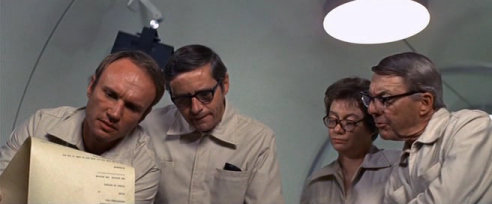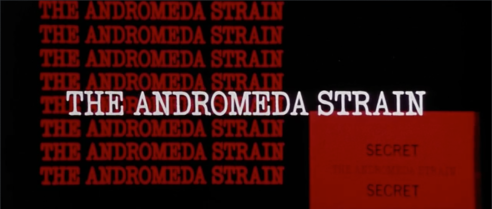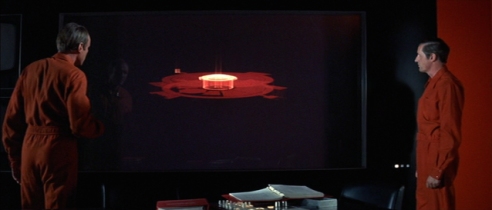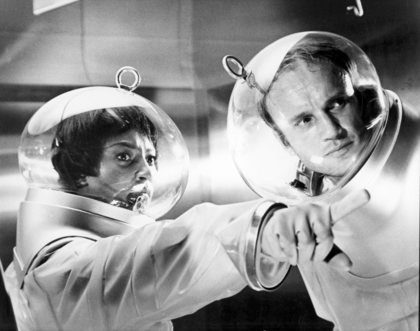The Andromeda Strain Film Review
 The blogger otherwise known as the Scientist Gone Wordy and I return to the genre that kicked off this duo post book slash movie review series of ours in the first place. Science-fiction. For the last of the dog days of summer, in my birth month of August, which is fitting. If we can’t do another Philip K. Dick at this point, well, a certain début novel (at least under the author’s real name), will have to do.
The blogger otherwise known as the Scientist Gone Wordy and I return to the genre that kicked off this duo post book slash movie review series of ours in the first place. Science-fiction. For the last of the dog days of summer, in my birth month of August, which is fitting. If we can’t do another Philip K. Dick at this point, well, a certain début novel (at least under the author’s real name), will have to do.
The Andromeda Strain.
The late-Michael Crichton was one of the first progenitors for the hybrid genre known as the techno-thriller. In many ways, he laid the groundwork with that class of fiction with his startling thriller of a best-seller. As usual, the wordy one will peruse his 1969 novel, which served as the basis for its 1971 adaptation by a filmmaker known for producing some of the best in this imaginative genre, which I’ll examine. Rachel’s book review can be found here:
The Andromeda Strain by Michael Crichton
A brief synopsis of the film: Two crew members of “Project Scoop”, a secret U.S. government program, investigate the town of Piedmont, New Mexico to retrieve their wayward Scoop 7 satellite. Finding dead townspeople in the streets, even dying themselves while reporting back to Scoop Mission Control, the Wildfire protocol is activated. An elite scientific team previously recruited for just this type of emergency. Two of their hazmat-suited members drop down, locate the opened satellite, and dozens of corpses. All with fully clotted blood turned to powder. Retrieving Scoop 7, they find something even more unexpected. Two survivors — a 62-year-old man and a six-month-old infant. Taking everything back to their super-secret underground lab, they’ll attempt to discover the mystery behind it all, if they don’t manage to initiate the facility’s fail-safe device which will blow them to kingdom come, that is.
[spoiler warning: some key elements of the film could be revealed in this review]
“The defense system is perfect, Mark. It’ll even bury our mistakes!”
As mentioned, I’ve a history with this novel, being I read it in one day while home sick (sorta) from high school. Deliciously thrilling and tense, the novel in a way infected me with its own need for more. More tech, more thrills, and for God’s sake stay far, far away from me, if you’re sick with anything! I obviously remember when it was announced, some time during 1970 I think, the novel was to be adapted to film. Even that Robert Wise, a longtime favorite of mine who helmed a number of films that have stayed close to my heart, was to direct it. This just HAD to be good.
It was, but in its own distinct way even some fans of the novel hadn’t expected.
Filmmaker Robert Wise managed to take a megahit book and transfer it from the page, and reader’s heads, onto the big screen. Simple, right? Not often, given the translation some books to film receive. My own children voiced this isn’t always so. Quoting Roger Ebert, they “…hate, hate, hate” what was done to their favorite childhood book, Where the Wild Things Are by director Spike Jonze. Given enough rope, you can screw up anything. Luckily, emphasizing a documentary style, with plenty scientific background research, Wise put a face to all those science-facts the young novelist had conjured up for this translation.
Crichton’s central point being, also shadowed in Fail-Safe, all technology’s advancement in human endeavor comes with risks.
 Especially for those who insist they know what they’re doing. Crichton set and used the arrogant tone for some his characters throughout his writing career care of this novel. Still, adapting a work so thoroughly tied with science fact along with its science fiction the essential task for the production. In that, Wise’s choice of Nelson Gidding, who worked with the director for the stellar and disturbing The Haunting (which we looked at last year) and would again in The Hindenburg (1975), to write the screenplay was equally crucial. Gidding convinced the director for the biggest, and most successful, change to the material.
Especially for those who insist they know what they’re doing. Crichton set and used the arrogant tone for some his characters throughout his writing career care of this novel. Still, adapting a work so thoroughly tied with science fact along with its science fiction the essential task for the production. In that, Wise’s choice of Nelson Gidding, who worked with the director for the stellar and disturbing The Haunting (which we looked at last year) and would again in The Hindenburg (1975), to write the screenplay was equally crucial. Gidding convinced the director for the biggest, and most successful, change to the material.
Revising the clinical microbiologist, Peter Leavitt of the novel, to that of a woman.
“Establishment gonna fall down and go boom.”
Of late, I’d imagine Ruth coming up with the Gwen DeMarco (Galaxy Quest) observational moment with having a thermonuclear bomb at the facility, “…it makes no logical sense, why is it here?”
Ruth Leavitt, as portrayed by Kate Reid, the delightfully scheming mother in This Property is Condemned, was easily the most realized persona among the four scientific members of team Wildfire brought over. The screenwriter’s seasoned sense saw it offered a pivotal dynamic not in the book for the epileptic scientist and said so. Wise didn’t want another “Raquel Welch in a submarine” moment (Fantastic Voyage), though. Luckily, Gidding persisted and won out when Wise ran it by some scientist friends. They confirmed there were females in the field. Rather extraordinary ones, in fact. Whether envisioned or not, Ruth became the most interesting character of the film, bar none.
Nevertheless, Robert Wise proved the best choice in leading this adaptation’s sci-fi effort. His bona fides with The Day The Earth Stood Still (1954), and later Star Trek: The Motion Picture (1979), stand up for themselves. His straightforward approach still refreshing upon revisit, and in keeping with some of best of this bent that decade (Colossus: The Forbin Project, THX 1138, Silent Running, Phase IV). Blessed it, in fact, as the noted director-producer-editor’s keen eye was always in play. He and Richard H. Kline, the director of photography, enhanced the look of the piece by shooting in CinemaScope.
With extensive use of the diopter to keep in focus a number of scenes’ background, it was another splendid touch by the well-versed director. Minimizing the depth of focus issues, magnifying the reality Wise sought to portray, thus keeping the story inline with Crichton’s (and Gidding’s) plotting1. All helping to build tension as the scientists stress themselves to discover the secret of the mysterious lethal strain in their midst. Widescreen a further plus to the production when framing the dead in the field, or the living in the lab. Along with split-screen and storyboard use, the filmmaker’s full tool-set was deployed to maximum effect.
With one of the most distinctive sets ever put together on film.
The entire underground complex, like the monastery in The Name of the Rose, dominated the subsurface landscape onscreen. The sterile quality of the set purposeful for the achieved outcome filmmakers wanted. The documentary quality, with unadorned coldness. Three scientists were consulted and four-million dollars in technical equipment borrowed to help convey that in its art direction. Only one tunnel in the entire set, too. All scenes were shot per color-coded level of the tale, then just repainted for those that would come the next. Set designer Boris Levin had a field day rendering the idea put forth from Crichton’s imagination.
The extensive use of illustrative electronic diagrams to describe and display the underground facility came byway of Nelson Gidding’s and Levin’s brainstorming. Douglas Trumbull, late of 2001: A Space Odyssey and working on Silent Running at the time, provided the extraordinary special effects, along with the macro- and micro-photography used in scenes for eye-popping impact. None of it was CGI. Even capturing the close-circuit video of the time on film, a first. Electron-optical printing and photographic capture from the microscope, along with the computer-controlled cameras, were invented on the fly by Trumbull’s team.
Even the god of his art, Albert Whitlock’s matte paintings augmented the central core sequences when the film entered its tense closing act. A fascinating Gil Mellé musical score, distinctive for the genre, which may be a tad dated today, made a remarkable entrance with The Andromeda Strain‘s exceptional opening titles sequence.
The film, given its age and genre, was influential, ultimately. The scenario of a potentially catastrophic microorganism kept in an underground secret facility, with an automated, coldly calculated measure to eliminate all within, if containment was lost, sounds familiar, does it not? Replicated decades later for the horror fiction Resident Evil video game and subsequent film adaptations. Douglas Trumbull was so influenced by the experience on Wise’s film adaptation, he’d used the knowledge gained, with that of the manipulator hand equipment seen, to do the notable cloud sequence in Close Encounters of the Third Kind.

“Michael Crichton was invited to take a tour of Universal Studios during the production of this film. His guide was none other than Steven Spielberg, who went on to adapt his most successful novel, Jurassic Park (1993)” ~ IMDB.
Yeah, I’ve overemphasized the film’s technical aspects in this review. Visually, they really do standout, but it is more flesh and bone than that. Even so, those aspects may have distanced the audiences not into all that. Or familiar with the novel. It was a techno-thriller and you have to know that going in, which may limit this to the more geeky out there who’d eat this up. Outside of Kate Reid, the decision to utilize conventional character actors James Olson, Arthur Hill, and David Wayne for the film’s factual feel and fill out the central foursome, may have minimized the draw for moviegoers. Only the women, Kate and the underutilized Paula Kelly, sizzle with real life in the plot-heavy story, to tell the truth.
“601! The computer is overloaded. Too much data coming in too fast.”
Still in all, an exceptional best-seller was turned into an excellent screenplay, and thus a noteworthy, and a bit unsettling2, sci-fi film by Robert Wise. Par for the course, if you ask me.
Parallel Post Series
- Hombre
- The Bourne Identity
- Empire of the Sun
- Misery
- The Name of the Rose
- I Am Legend
- The Right Stuff
- – 2013 posts
- – 2012 posts
- – 2011 posts
- – 2010 posts
- Another interesting aspect of Crichton’s novel was its bibliography. While it looked like a thoroughly researched work, and it was, the index the author included was entirely fictitious! Writer Gidding copied the concept into his screenplay. All the dialogue that occurs over the PA, which sounded convincing, was all made up. ↩
- The chilling scene with the Rhesus monkey wouldn’t pass muster with animal-rights supporters today. They placed the animal into a carbon dioxide environment so it would look convincing in its death throes — and it really was dying onscreen — before flashing it back to life with oxygen off-screen. SPCA approved, mind you. ↩








11 Responses to “The Andromeda Strain Film Review”
Oh this is by Michael Crichton? Well given how much I LOVE Jurassic Park and even Timeline, I should enjoy this one. Thanks Michael!
LikeLiked by 1 person
Both the novel and film are well worth checking out, Ruth. Thanks, my friend 🙂
LikeLike
Much like with the novel, I’m going to need to go back and give this one another view. I think I read the novel for the first time about 15 years ago (or more?) and watched the movie soon thereafter. I’m looking forward to queuing it up again. (Obviously, I’m too busy watching football this weekend:)).
As you mentioned, I remember it doing a very good job of incorporating the techno elements of the novel. It is a story and style that really does appeal to a certain kind of audience. Very satisfying if you’re part of it, possibly not so much if you’re not.
Awesome GQ quote! It’s one of my faves and quite useful in everyday life.
Glad we did this one, and I hope we’ll visit Crichton’s work again. I can’t believe it’s been three years since Jurassic Park!
Thanks, Michael!
LikeLiked by 1 person
I was happy you picked this one, Rachel. Great to look back at both the novel and film. I thought you’d appreciate that Galaxy Quest quote 😉
Yes, it was great to get back to another Michael Crichton work. Perhaps, another one for next season? I know one right off the top of my head (but I’ll keep it offline for the moment). No, it’s not The Lost World: Jurassic Park.
Thanks, Rachel 😀
LikeLike
[…] The Andromeda Strain […]
LikeLike
[…] survivors.. The andromeda strain movie review (1971) | roger ebert, Robert wise’s "the andromeda strain" works reasonably well as science fiction, but […]
LikeLike
[…] the most creepy, unsettling, yet oddly mesmerizing original tracks this side of Forbidden Planet or The Andromeda Strain. Any snippet from the soundtrack makes that abundantly clear. What you realize in watching the […]
LikeLike
[…] The Andromeda Strain […]
LikeLike
[…] Side Story, The Sound of Music), Horror (The Haunting), Sci-Fi (The Day the Earth Stood Still, The Andromeda Strain), and the war film. This one easily the standout in that […]
LikeLike
[…] you had was a fairly compelling story — using a variation of The Andromeda Strain template — that could have made its sci-fi premise an interesting one for the big screen. […]
LikeLike
[…] novel, after The Great Train Robbery, to go at right angles from his first two techno-thrillers (The Andromeda Strain and The Terminal Man) and into historical fiction. As in his debut novel, the author fabricated an […]
LikeLike